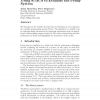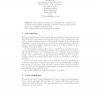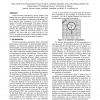1299 search results - page 14 / 260 » Why Not Use a Pattern-Based Parallel Programming System |
SLP
1997
13 years 9 months ago
1997
We demonstrate the bene ts of instruction-set simulation in the evaluation of a parallel programming system, Penny. The simulator is a reliable tool in exploring design alternativ...
MEMBRANE
2005
Springer
14 years 1 months ago
2005
Springer
Some features capturing the computational completeness of P systems with maximal parallelism, priorities or zero-test using symbol objects are studied through Petri nets. The obtai...
IPPS
2002
IEEE
14 years 16 days ago
2002
IEEE
Object-oriented programming, design patterns, and frameworks are common techniques that have been used to reduce the complexity of sequential programming. We have applied these te...
AAAI
2008
13 years 10 months ago
2008
Answer-set programming (ASP) is widely recognised as a viable tool for declarative problem solving. However, there is currently a lack of tools for developing answer-set programs....
IPPS
2000
IEEE
13 years 12 months ago
2000
IEEE
This paper presents a new approach to improve performance of Java programs by extending the superthreaded speculative execution model [14, 15] to exploit coarsegrained parallelism...



